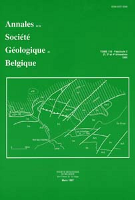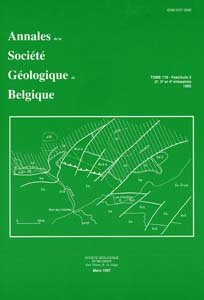- Accueil
- Volume 117 (1994)
- Fascicule 1 - Stratigraphie du Paléozoïque : Homma...
- The earliest European Streblochondriid bivalves (Pteriomorphia; late Famennian)
Visualisation(s): 573 (2 ULiège)
Téléchargement(s): 1351 (3 ULiège)
The earliest European Streblochondriid bivalves (Pteriomorphia; late Famennian)

Résumé
Les bivalves streblochondriens européens anciens (Pteriomorphia, Famennien récent). La révision de la faune à bivalves du Famennien récent du bord sud de Laurussia a démontré que beaucoup de groupes à bivalves, dont la première apparition était supposée dans le Carbonifère ancien jusqu'à ce jour, descendent jusqu'au Famennien récent. Des bivalves streblochondriens sont retrouvés dans le Famennien récent sous la forme de leur représentants les plus anciens, Streblopteria piltonensis (Whidborne, 1896) et Streblopteria lepis (Whidborne, 1896), tous les deux apparaissent dans le faciès clastique de plateau continental du Famennien récent («Strunien»). Ils font partie de la faune très diversifiée de plateau continental du dernier sous-cycle de transgression-régression du Dévonien. L'origine des streblochondriens doit être recherchée dans le Famennien ancien après la crise Frasnien/Famennien, leur développement majeur et la diversification du groupe a eu lieu dans les mers du plateau continental du Carbonifère. Les streblochondriens sont un des rares groupes de bivalves qui montrent des relations paléogéographiques et paléoécologiques avec la faune du faciès «basinal» du Dévonien supérieur et du Carbonifère inférieur. La valeur taxonomique des caractères morphologiques et l'état des connaissances de la classification des streblochondriens est discutés dans l'introduction du présent travail; Streblopteria piltonensis et Streblopteria lepis sont décrits en détail et révisé dans la partie systématique.
1-17
Abstract
Revision of the Late Famennian bivalve fauna from the southern coast of Laurussia has revealed that various groups of bivalves, up to now regarded as appearing in the Early Carboniferous, are now proved to range back into the Late Famennian. Streblochondriid bivalves can be traced back into the Late Famennian, through their oldest members, Streblopteria piltonensis (Whidborne, 1896) and Streblopteria lepis (Whidborne, 1896), both occurring in the clastic shelf facies of the Latest Famennian. They form part of the highly diversified shelf fauna of the last transgression-regression subcycle of the Devonian. The origin of streblochondriids has to be dated back in the Early Famennian after the Frasnian/Famennian Crisis, whereas the main development and diversification of the group occurred in the shelf region of the marine Carboniferous. Streblochondriids are one of the rare groups of bivalves that show palaeogeographical and palaeoecological relations to the fauna of the "basinal" facies of the Upper Devonian and Lower Carboniferous. In the introductory part of this paper the taxonomical value of morphological features and the taxonomical state of knowledge is discussed. In the systematic part Streblopteria piltonensis and Streblopteria lepis are described and revised in detail.
Zusammenfassung
Die ältesten europäischen Streblochondriiden (Pteriomorphia, Spätes Famennium). Die Revision der spät-famennischen Bivalvenfauna am Südrand von Laurussia hat gezeigt, daß zahlreiche Bivalvengruppen, deren Ursprung bisher im tieferen Unterkarbon angenommen wurde, bis in das höhere Famennium zurückreichen. Dies gilt auch für Streblochondrien, deren älteste Vertreter, Streblopteria piltonensis (Whidborne, 1896) und Streblopteria lepis (Whidborne, 1896), in der Fazies des klastischen Schelfes im Ober-Famennium („Strunium“) vorkommen. Sie bilden damit einen Anteil an der hoch diversen Schelffauna während des letzten Transgressions-Regression-Subzyklus im Devon. Der Ursprung der Streblochondrien muß im frühen Famennium nach der Frasnes/Famenne-Krise gesucht werden, während die Hauptentwicklung und Diversifizierung in den Schelfmeeren des Karbons erfolgte. Streblochondrien gehören zu den wenigen Bivalvengruppen, die paläogeographische und paläoökologische Beziehungen zur „Beckenfazies“ im Oberdevon und Unterkarbon zeigen. Im einführenden Teil dieser Arbeit wird der taxonomische Stellenwert morphologischer Eigenschaften und der taxonomische Kenntnisstand der Streblochondrien diskutiert; im systematischen Teil werden Streblopteria piltonensis und Streblopteria lepis ausführlich beschrieben und diskutiert.






